Hohenlinden 1800:
The Forgotten Battle
The Commanders of the
French and Austrian Armies
by Guenter Schneider, Germany
| |
In 1793 he was appointed general of brigade. In 1796 Moreau became commander in chief of an army for the first time. It was the Army of the Rhinet-Moselle which he led across the Rhine, but without great success; the French had to break off their invasion in Germany. It was in Italy where the decisive events took place. In 1799 he was at the Army of Italy where he served under Schérer and Joubert. At the end of the year the Directory gave him the command of the Army of the Rhine, the most republican army of France. Neerwinden, Tourcoing, Biberach, Cassano and Novi are only a few names which marked the way of Moreau´s military career. At this time Moreau was one of the most capable generals of the French Republic and he was very popular with his soldiers. On the other side there was Paul Kray Freiherr von Krajova (1735-1804) who was an Hungarian from birth. He entered the Austrian service at the age of nineteen. He served during the Seven-Years-War and became a general after the war against the Turcs in 1790. At the beginning of the year 1800 he took the command of the Austrian army in Germany from Archduke Charles who resigned the supreme command. At the end of August Kray had to leave his post because according to the opinion of the members of the Aulic Council of War he was too defensive and too careful.
He took the supreme command in September because his brother Charles had refused it. General von Lauer (1735-1803) had to become his military adviser during the following campaign. Archduke John suffered much under the terrible defeat at Hohenlinden, but in 1805 he took the command over the Austrian troops in Tyrol. In 1809 he supported the insurrection in Tyrol. In the same year he took the command over the army of the South in Carinthe, which consisted of the VIIIth and IXth Austrian corps. At Raab he was defeated by Eugène Beauharnais and for that reason he could not partici pate in the battle of Wagram. This was his last military command. In Austria in the following years he became very popular by social, cultural and economic enterprises.
Baillet de Latour (1737-1806) (left) had even participated in the battle of Kolin against Frederic the Great in 1757 during the Seven Years War, a year in which most of the French generals at Hohenlinden had not yet been born. Some of the French generals should be introduced here. There was Grenier (1768-1827) from Sarrelouis, nowadays a German town, but at that time a French town in Lorraine since 1680. Grenier had seen many battlefields of the revol ut io nary wars. Being a general for six years he was at Valmy, Jemmappes, Hondschoote, Wattignies and Fleurus. One of his commanders of division was Michel Ney (1769-1815) who came from Sarrelouis, too. He was more German than French and his mother tongue was German. Ney was a general for four years and he had seen many great days of the revolutionary armies, too. Neerwinden, Fleurus, Aldenhoven, Altenkirchen and Mainz were only a part of them. In the later years he would become Marshal of France, Duke of Elchingen and Prince of the Moskowa. He participated in the last great battle of the Napoleonic era, and there at Waterloo he fought like a lion, with the only result to be executed as a traitor by order of a court-martial.
The French generals were much younger than the Austrians, and probably this was the reason for their success. The average age of the French generals of division at the Army of the Rhine was less than thirty-eight years. Hohenlinden 1800 The Forgotten Battle
The Campaign in South Germany The Commanders of the French and Austrian Armies The Hostilities Re-Open Battle of Hohenlinden The Aftermath French Army of the Rhine Austro-Bavarian Army Back to Table of Contents -- First Empire #64 Back to First Empire List of Issues Back to MagWeb Master Magazine List © Copyright 2002 by First Empire. This article appears in MagWeb (Magazine Web) on the Internet World Wide Web. Other military history articles and gaming articles are available at http://www.magweb.com |

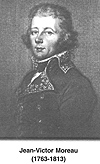 The commander in chief of the French
was Jean-Victor Moreau (1763-1813) (right). He
was born in Morlaix in Brittany as son of a
lawyer. In 1781 he started studying law in
Rennes, because his father wished him to do
so. But Jean-Victor already dreamed of a
military career. After the outbreak of the
French Revolution Moreau appeared on the
political scene and he was elected as a
lieutenant-colonel in the first volunteer
bataillon of the departement Ille-et-Vilaine.
With the beginning of the war he left
Brittany and served in the army of the North
under Dumouriez and later under Pichegru.
The commander in chief of the French
was Jean-Victor Moreau (1763-1813) (right). He
was born in Morlaix in Brittany as son of a
lawyer. In 1781 he started studying law in
Rennes, because his father wished him to do
so. But Jean-Victor already dreamed of a
military career. After the outbreak of the
French Revolution Moreau appeared on the
political scene and he was elected as a
lieutenant-colonel in the first volunteer
bataillon of the departement Ille-et-Vilaine.
With the beginning of the war he left
Brittany and served in the army of the North
under Dumouriez and later under Pichegru.
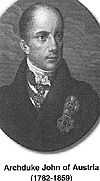 His successor was the younger brother of the
Emperor Francis II and of Archduke
Charles: the eighteen-year-old Archduke
John (1782-1859) (right), who had received a very
good military education. In 1795 he became
the owner of the regiment of dragoons No. 1.
His successor was the younger brother of the
Emperor Francis II and of Archduke
Charles: the eighteen-year-old Archduke
John (1782-1859) (right), who had received a very
good military education. In 1795 he became
the owner of the regiment of dragoons No. 1.
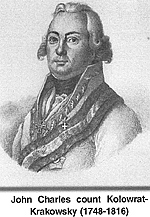
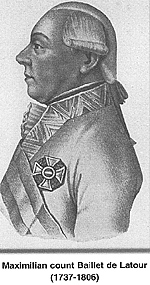 The other Austrian commanders were
much older than John: Kienmayer (1755-
1828), Riesch (1750-1821) and Kolowrat
(1748-1816) (right) had already seen fighting in
1778 during the War of the Bavarian
Succession.
The other Austrian commanders were
much older than John: Kienmayer (1755-
1828), Riesch (1750-1821) and Kolowrat
(1748-1816) (right) had already seen fighting in
1778 during the War of the Bavarian
Succession.
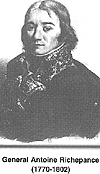 A young general of division called
Antoine Richepance (1770-1802) (right) was
member of Moreau´s corps. He was thirty
years old and he had been serving in a
regiment of dragoons in Metz since his
childhood. In 1794 he served as a captain of
the first regiment of chasseurs at Fleurus.
On the battlefield of Altenkirchen in 1796
he was appointed general of brigade by
Kléber, and on the battlefield of Fossano in
1799 he was appointed general of divison
by Champion net.
A young general of division called
Antoine Richepance (1770-1802) (right) was
member of Moreau´s corps. He was thirty
years old and he had been serving in a
regiment of dragoons in Metz since his
childhood. In 1794 he served as a captain of
the first regiment of chasseurs at Fleurus.
On the battlefield of Altenkirchen in 1796
he was appointed general of brigade by
Kléber, and on the battlefield of Fossano in
1799 he was appointed general of divison
by Champion net.